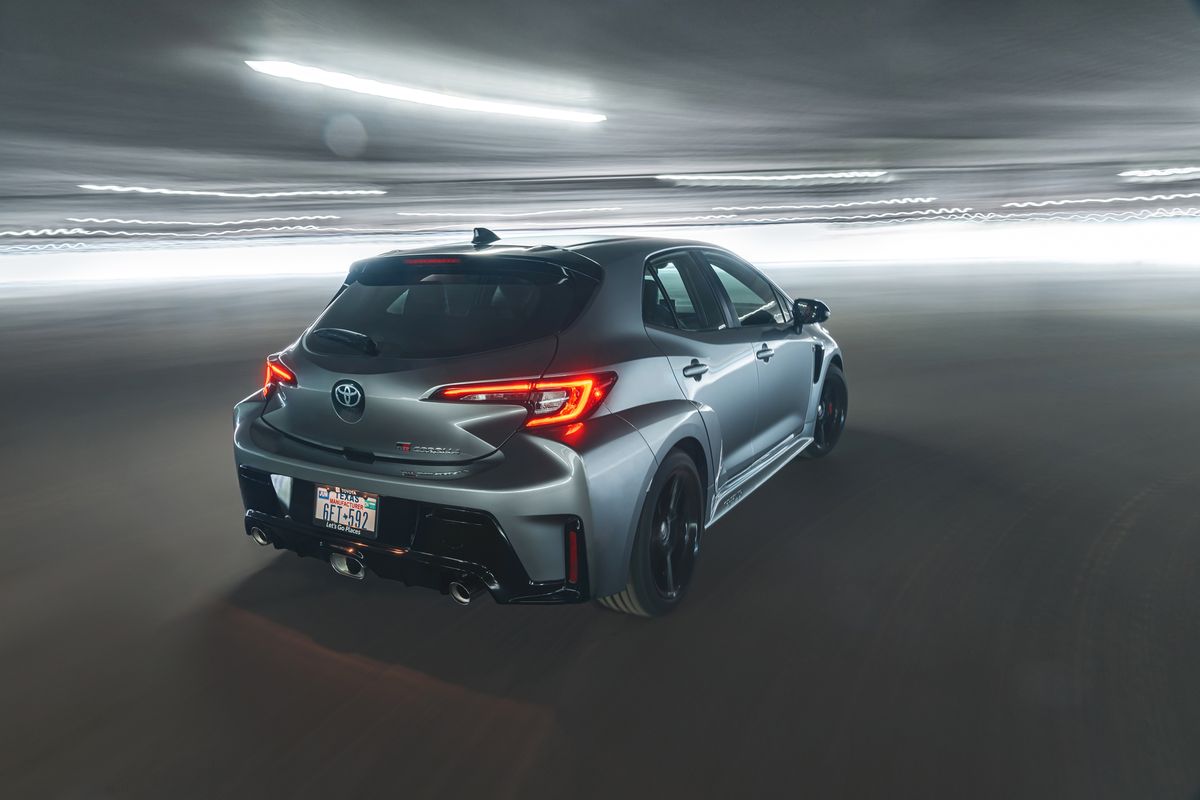Tested: 2023 Toyota GR Corolla Circuit Is a Rally-Bred Riot

From the November 2022 issue of Car and Driver.
Toyota wore the stink of appliance-grade transportation with pride for a long time. Reliability is neither sexy nor fun—unless you’re into actuarial science, in which case, are you reading the right rag? But the past decade has been different for Toyota. It introduced two codeveloped rear-wheel-drive sports cars—the GR86 with Subaru and the Supra with BMW, both 10Best winners—plus a rally-inspired GR Yaris for overseas markets. Now we get the Yaris’s larger sibling, the GR Corolla. Are we crazy, or is Toyota the leading enthusiast brand of the day?
The GR Corolla is an absolute beauty. It’s capable of speeds as fast as anyone should feel comfortable going on public roads. The 143-mph governor can be reached on the street, but if you drive that fast on two-lane roads, you probably belong in a cage.
We tested the mid-grade Circuit trim, which starts at $43,995. A base Core model is $7000 cheaper, and a $7000-pricier two-seat Morizo edition will come later in 2023.
At the heart of the GR Corolla is a 1.6-liter inline-three, a spunky little mill that also powers the GR Yaris. With a 10.5:1 compression ratio and a tiny turbo generating up to 25.2 psi of boost in the Core and Circuit models, it’s not without lag—the GR Corolla’s 5-to-60-mph time is 6.4 seconds—but it isn’t even the slightest bit offensive. A balance shaft cancels the inherent imbalance of the triple, and the passenger’s-side powertrain mount is liquid filled to further quell shakes.
If you’re hoping for the wild three-cylinder wail of a Yamaha motorcycle or snowmobile, you’ll be disappointed. Despite the presence of a two-stage intake and exhaust and the occasional blow-off-valve whoosh, the engine sounds totally normal. It’s more like a four than other automotive threes of recent memory—BMW i8, Mitsubishi Mirage, or Smart ForTwo. When Toyota developed this engine for the Yaris, three engineering teams in the United States, Germany, and Japan worked together using computer-aided engineering to produce a working prototype in six months, about half the time of typical development. In the Corolla Core and Circuit models, it makes 300 horsepower at 6500 rpm and 273 pound-feet at 3000 rpm. The torque curve stays flat up to 5500 rpm. The Morizo edition gets a midrange bump to 295 pound-feet courtesy of a little more boost.
The very stout driveline is seemingly impervious to the engine’s best efforts to destroy it. Borrowed from the homologation-special GR Yaris, the all-wheel-drive system and transmission were developed with private rally teams in mind. Following the best-practices advice of Toyota R&D, we launched the GR like a rally car, with lots of clutch slip. The GR Corolla swallowed all the abuse we could throw at it, and we never even smelled the dreaded stink of vaporized clutch material.
For the best launch, hold revs near the limiter and make sure the engine doesn’t dip below 4000 rpm. But the driveline wasn’t developed for reaching 60 mph in second gear. Thus, the 4.9-second 60-mph time doesn’t fully represent the car’s quickness off the line. Eliminate a shift and the GR would run quicker than the manual hot-hatch leader Volkswagen Golf R, with its 4.7-second sprint. The GR makes up some time in the quarter-mile, tying the VW with a 13.3-second run. The prototype we tested came straight from the media launch, and both the second- and third-gear synchros were easily beat. We’re confident our next go with a GR will result in even more impressive test results.
And it had better, because 300 horses is the opening bid in this segment. The Golf R and the Honda Civic Type R accomplish this, albeit from larger-displacement engines. The Corolla makes up for lack of a knockout punch by keeping mass trim. The Circuit’s standard forged carbon-fiber roof helps Toyota deliver all-wheel drive in a 3269-pound curb weight. The front-drive Type R, which gets replaced any day (come back next month), is about 100 pounds lighter.
The Circuit’s standard front and rear Torsen differentials maximize grip. Drivers can select from three torque splits for the center clutch-pack coupler, with 70, 50, or 40 percent of available torque driving the rear axle. Toyota says the best performance comes from the 50:50 Track mode.
Acceleration alone doesn’t make this car wonderful. Even better is its compliance on Michigan’s carpet-bombed roads. Fixed-rate dampers provide a ride-handling balance reminiscent of a ’90s BMW. There are no electronic crutches to toggle the suspension from soft to firm, yet jounce is never so abrupt that it violently tosses your head. The spring and bushing selections seem perfectly matched to the reinforced econocar unibody.
